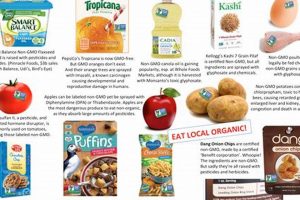Food products formulated without dairy ingredients, and specifically designed for infants, constitute an important segment of the pediatric nutrition market. These products are formulated to exclude cow’s milk, or any ingredients derived from it, such as whey, casein, and lactose. For example, an infant formula based on hydrolyzed rice protein falls into this category.
The importance of these specialized food options stems from several factors, including the prevalence of cow’s milk protein allergy (CMPA) and lactose intolerance in infants. Offering alternatives allows for proper nutrition and growth in babies who cannot tolerate dairy, minimizing adverse reactions such as gastrointestinal distress, skin rashes, and respiratory issues. Historically, specialized formulas and pures have evolved to meet the increasing awareness of food sensitivities in early childhood.
This article will explore the various types of these specialized baby foods, the ingredients they commonly contain, considerations for selecting appropriate products, and guidance on introducing these foods to an infant’s diet.
The following are guidelines to consider when incorporating dairy-free options into an infant’s diet. These recommendations address selection, introduction, and nutritional adequacy.
Tip 1: Consult a Pediatrician. Prior to introducing a dairy-free diet, a consultation with a pediatrician or registered dietitian is essential. Professional guidance ensures the diet is appropriate for the infant’s specific needs and addresses potential nutrient deficiencies.
Tip 2: Scrutinize Product Labels. Carefully examine ingredient lists for hidden sources of dairy, such as whey, casein, lactose, and milk solids. Manufacturers frequently use these ingredients in processed foods.
Tip 3: Consider Hydrolyzed Formulas. Hydrolyzed formulas, containing proteins broken down into smaller peptides, are often suitable for infants with CMPA. Extensively hydrolyzed formulas are generally more effective than partially hydrolyzed options.
Tip 4: Introduce New Foods Gradually. Implement a gradual introduction of new foods, observing the infant for any adverse reactions. Introduce one new food at a time, waiting several days before introducing another, to identify potential allergens.
Tip 5: Ensure Adequate Calcium Intake. Dairy-free diets require alternative calcium sources. Fortified plant-based milks, such as soy or almond milk (if age-appropriate and approved by a pediatrician), and dark leafy green vegetables can contribute to calcium intake.
Tip 6: Monitor Iron Levels. Iron deficiency is a common concern in infants. Dairy-free diets should include iron-rich foods, such as fortified cereals, pureed meats, and legumes. Consult with a pediatrician regarding potential iron supplementation.
Tip 7: Address Vitamin D Needs. Vitamin D is crucial for bone health and immune function. Supplementation may be necessary, particularly if the infant has limited sun exposure. Consult with a healthcare provider to determine the appropriate dosage.
Following these tips can facilitate a smooth transition to a dairy-free diet, supporting optimal infant health and development. Careful planning and professional guidance are key to ensuring nutritional adequacy.
The subsequent sections of this article will delve deeper into specific types of products and address common concerns related to dairy-free infant nutrition.
1. Ingredient Substitutions
Ingredient substitutions represent a cornerstone of crafting effective options for infants requiring alternatives that are dairy-free. The necessity for these substitutions arises from the complete avoidance of cow’s milk protein and lactose, integral components of traditional infant formulas and many commercially prepared baby foods. Consequently, formulating products specifically avoids any ingredients derived from milk, requiring careful selection of replacements that maintain nutritional integrity and palatability. A direct consequence of this is the replacement of whey protein with extensively hydrolyzed protein.
The importance of suitable substitutions cannot be overstated, as they directly impact an infant’s growth, development, and overall health. For example, soy-based formulas, though traditionally employed, may not be suitable for all infants due to potential soy allergies or sensitivities. Rice protein hydrolysate formulas have emerged as a viable option for CMPA. In solid foods, the use of pureed fruits and vegetables, such as sweet potato or avocado, replaces dairy-based creams or yogurts, providing essential vitamins and minerals.
Ultimately, the successful implementation of ingredient substitutions in specialized offerings necessitates thorough knowledge of infant nutritional requirements and potential allergenic ingredients. Challenges exist in ensuring complete nutritional equivalence and addressing taste preferences. Therefore, continuous research and development are crucial to enhance these specialized foods and broaden their acceptance. The strategic application of these substitutions is fundamental to the availability of safe and nutritionally adequate options for infants requiring dairy avoidance.
2. Nutritional Adequacy
Nutritional adequacy is a paramount consideration in the context of dairy-free baby food. The exclusion of dairy necessitates meticulous attention to ensure that infants receive all essential nutrients, which are typically provided by dairy sources. Failure to achieve nutritional adequacy can lead to developmental delays, growth impairment, and increased susceptibility to illness. For example, infants with CMPA relying solely on rice cereal without proper supplementation may develop iron deficiency anemia.
Specifically, calcium, vitamin D, protein, and certain B vitamins are critical nutrients that must be addressed through alternative sources. Fortified plant-based formulas, such as those based on soy or hydrolyzed rice protein, often serve as substitutes for cow’s milk-based formulas, providing a balanced nutrient profile. In the realm of solid foods, parents and caregivers must prioritize nutrient-dense options, such as dark leafy greens, legumes, and fortified cereals, to compensate for the absence of dairy. Regular monitoring of growth parameters and nutrient levels, in consultation with a pediatrician or registered dietitian, is crucial to ensure that an infant’s nutritional needs are adequately met.
In conclusion, maintaining nutritional adequacy in dairy-free infant diets is a complex undertaking that demands careful planning and execution. While the avoidance of dairy is essential for certain infants, it necessitates proactive strategies to prevent nutrient deficiencies and support optimal health. A multidisciplinary approach, involving healthcare professionals and informed caregivers, is essential for navigating the challenges and maximizing the benefits of dairy-free infant nutrition.
3. Allergen Avoidance
Allergen avoidance is a central tenet of formulating and selecting specialized options for infants. For infants diagnosed with cow’s milk protein allergy (CMPA) or lactose intolerance, meticulous avoidance of dairy allergens is not merely a preference but a medical necessity to prevent adverse reactions and ensure optimal health.
- Label Scrutiny
Rigorous examination of product labels is paramount in allergen avoidance. Manufacturers may use various terms to denote dairy ingredients, including whey, casein, lactose, and milk solids. Overlooking these hidden sources can trigger allergic reactions. For example, a seemingly innocuous “fruit puree” might contain whey protein as a thickening agent. Therefore, caregivers must meticulously scrutinize every ingredient listed on the packaging.
- Cross-Contamination Prevention
Preventing cross-contamination during food preparation is crucial, especially in households where other family members consume dairy products. Shared utensils, cutting boards, and cooking surfaces can transfer trace amounts of dairy allergens to dairy-free meals. Dedicated preparation areas and thoroughly cleaned equipment are essential to minimize this risk. For instance, a shared blender used to make both dairy-based smoothies and dairy-free purees poses a significant cross-contamination risk.
- Alternative Ingredient Selection
Selecting appropriate alternative ingredients is fundamental to ensuring both allergen avoidance and nutritional adequacy. Plant-based alternatives, such as soy, rice, or oat milk, may be used as substitutes for cow’s milk. However, caregivers must be cognizant of potential cross-reactivity. Extensive labeling and confirmation from manufacturing process must be considered. Also, a rice-based formula may be suitable for infants with CMPA but should be supplemented with iron to address nutritional needs.
- Symptom Monitoring
Close monitoring of an infant’s symptoms following the introduction of new foods is essential for detecting potential allergic reactions. Symptoms may range from mild gastrointestinal distress to severe anaphylaxis. Caregivers must be vigilant in observing for signs such as skin rashes, vomiting, diarrhea, or breathing difficulties. Prompt medical intervention is crucial in cases of severe allergic reactions. Documenting all food introductions in a food journal can help identify potential triggers.
Effective allergen avoidance strategies require a multifaceted approach encompassing label scrutiny, cross-contamination prevention, informed ingredient selection, and vigilant symptom monitoring. By adhering to these principles, caregivers can mitigate the risks associated with dairy allergies and ensure the well-being of infants requiring dairy-free options.
4. Age Appropriateness
Age appropriateness is a critical factor when selecting or preparing dairy-free options for infants. An infant’s digestive system, nutritional needs, and developmental abilities evolve rapidly during the first year of life. Therefore, foods suitable for a six-month-old may not be appropriate for a four-month-old, regardless of their dairy content.
- Texture and Consistency
The texture and consistency of infant food must align with the infant’s oral motor skills. Very young infants, typically under six months, require pureed foods with a smooth, liquid-like consistency to prevent choking. As infants develop the ability to manage thicker textures and chew, the consistency of the food can gradually progress to mashed, lumpy, and eventually soft, solid pieces. Dairy-free options, such as fruit and vegetable purees, must be prepared to the appropriate texture for the infant’s age. For example, offering a four-month-old a chunky dairy-free vegetable stew would pose a significant choking hazard.
- Nutritional Needs
Infants’ nutritional requirements vary significantly with age. Younger infants rely primarily on breast milk or formula for their nutritional needs. As they transition to solid foods, it is essential to ensure that the foods offered provide adequate calories, protein, vitamins, and minerals. Dairy-free foods must be carefully selected to compensate for nutrients typically provided by dairy products, such as calcium and vitamin D. For example, if offering a dairy-free cereal, it should be fortified with iron and other essential nutrients to meet the infant’s needs. It is also important to note that dairy-free does not automatically qualify the baby food, and a pediatrician’s confirmation is needed to provide necessary nutritional value.
- Digestive Capability
An infant’s digestive system matures over time, gradually developing the ability to digest more complex foods. Introducing foods that are too difficult to digest can lead to gastrointestinal distress, such as gas, bloating, or diarrhea. Dairy-free options, like legumes or cruciferous vegetables, should be introduced gradually and in small quantities to assess the infant’s tolerance. For instance, offering a large serving of broccoli puree to a six-month-old who has never consumed it before may cause digestive upset.
- Allergenic Potential
The introduction of potentially allergenic foods, including dairy-free options, should be carefully timed and monitored. While the focus is often on avoiding dairy allergens, other ingredients in dairy-free foods, such as soy or nuts, can also trigger allergic reactions. Introduce new foods one at a time, waiting several days before introducing another, to observe for any signs of allergy. Always consult with a pediatrician or allergist before introducing highly allergenic foods. It’s advisable to consult with the health professional that the baby is prepared to these foods, and there is no pre-existing conditions.
Ensuring age appropriateness in specialized offerings is paramount to support optimal growth, development, and digestive health. Caregivers must carefully consider texture, nutritional needs, digestive capabilities, and allergenic potential when selecting dairy-free food for infants. Consulting with healthcare professionals can provide personalized guidance and address any concerns.
5. Digestive Tolerance
Digestive tolerance plays a pivotal role in the successful implementation of dairy-free diets for infants. The ability of an infant’s gastrointestinal system to process and assimilate alternative food sources is essential to ensure adequate nutrition and overall well-being. Therefore, careful consideration of digestive tolerance is paramount when introducing or modifying a dairy-free feeding regimen.
- Enzyme Production
Enzyme production capacity directly impacts digestive tolerance. Infants with lactose intolerance lack sufficient lactase, the enzyme required to break down lactose, the primary sugar in milk. Introduction of dairy-free alternatives eliminates lactose, but consideration must be given to the infant’s ability to digest other complex carbohydrates and proteins present in these alternatives. For example, soy-based formulas require adequate protease activity for protein digestion, while rice-based products depend on amylase for carbohydrate breakdown. Insufficient enzyme activity can lead to gastrointestinal distress, such as gas, bloating, or diarrhea.
- Gut Microbiome Composition
The composition of the gut microbiome significantly influences digestive tolerance. A balanced gut microbiome aids in the digestion of various food components, including complex carbohydrates and fibers. Introduction of novel food sources, common in dairy-free diets, can alter the gut microbiome. For example, supplementation with probiotics may enhance digestive tolerance by promoting the growth of beneficial bacteria, improving digestion, and reducing inflammation. Dysbiosis, or an imbalance in the gut microbiome, can impair digestion and increase the risk of adverse reactions.
- Intestinal Permeability
Intestinal permeability, often referred to as “leaky gut,” can affect digestive tolerance. Increased intestinal permeability allows undigested food particles and bacteria to cross the intestinal barrier, potentially triggering an immune response and inflammation. Certain food ingredients, including some present in dairy-free alternatives, may increase intestinal permeability in susceptible infants. Hydrolyzed formulas, with smaller protein fragments, are often better tolerated due to reduced allergenicity and ease of digestion. Maintaining intestinal barrier integrity is crucial for optimizing digestive tolerance.
- Immune System Sensitivity
Immune system sensitivity plays a crucial role in the response to introduced foods. In infants with CMPA, the immune system recognizes cow’s milk proteins as foreign and mounts an allergic reaction. While dairy-free diets eliminate these allergens, infants may still exhibit sensitivity to other ingredients, such as soy or rice. Gradual introduction of new foods, one at a time, allows caregivers to monitor for any adverse reactions. Hypoallergenic formulas, extensively hydrolyzed or amino acid-based, are often recommended for infants with high immune sensitivity.
In conclusion, digestive tolerance is a multifaceted aspect of specialized nutrition, influencing the selection and management of dairy-free diets for infants. Enzyme production, gut microbiome composition, intestinal permeability, and immune system sensitivity all contribute to an infant’s ability to digest and tolerate alternative food sources. A comprehensive approach, incorporating careful food selection, gradual introduction, and close monitoring, is essential to optimize digestive tolerance and support the health and well-being of infants requiring dairy-free nutrition.
Frequently Asked Questions
The following questions address common concerns and misconceptions related to dairy-free diets for infants. These answers aim to provide clear, factual information to support informed decision-making.
Question 1: Is dairy-free baby food always necessary for infants with colic?
Dairy-free options may be considered for infants exhibiting colic symptoms if a cow’s milk protein allergy or intolerance is suspected. However, colic has multiple potential causes, and dairy elimination is not always the solution. Consultation with a pediatrician is necessary to determine the underlying cause of colic and implement appropriate interventions. Dairy-free formula must be carefully selected to replace the lost nutrients to maintain healthy growth.
Question 2: Can dairy-free diets lead to nutrient deficiencies in infants?
Yes, if not carefully planned and executed. Dairy products are a significant source of calcium, vitamin D, and protein. These nutrients must be adequately replaced through alternative sources, such as fortified plant-based formulas and nutrient-dense solid foods. Regular monitoring by a healthcare provider is essential to prevent deficiencies.
Question 3: Are all plant-based formulas nutritionally equivalent to cow’s milk-based formulas?
Not necessarily. While some plant-based formulas are designed to be nutritionally complete and meet the needs of infants, others may lack essential nutrients. It is crucial to select formulas that are specifically formulated for infants and are fortified with vitamins and minerals, such as calcium, vitamin D, and iron. A review of the nutrition label is necessary to confirm.
Question 4: How can one differentiate between lactose intolerance and cow’s milk protein allergy in infants?
Lactose intolerance involves difficulty digesting lactose, the sugar in milk, and typically results in gastrointestinal symptoms such as gas, bloating, and diarrhea. Cow’s milk protein allergy (CMPA) is an immune response to milk proteins and can manifest with a wider range of symptoms, including skin rashes, vomiting, and respiratory issues. Diagnostic testing, such as allergy testing or elimination diets under medical supervision, may be necessary for definitive diagnosis.
Question 5: Are hydrolyzed formulas truly dairy-free?
Extensively hydrolyzed formulas are designed to minimize allergenic potential by breaking down milk proteins into smaller peptides. While they are not entirely “dairy-free,” the reduced protein size makes them less likely to trigger allergic reactions in most infants with CMPA. However, a small percentage of infants with severe CMPA may still react to hydrolyzed formulas. Amino acid-based formulas represent a truly dairy-free alternative for these cases.
Question 6: How should new dairy-free foods be introduced to an infant’s diet?
New foods should be introduced one at a time, with a waiting period of several days between each introduction, to monitor for potential allergic reactions or digestive intolerance. Start with small portions and gradually increase the quantity as tolerated. Maintain a food journal to document any adverse symptoms. Consultation with a healthcare provider is recommended, especially when introducing highly allergenic foods.
Successful dairy-free feeding hinges on careful planning, diligent ingredient selection, and close monitoring of the infant’s response. Professional guidance is crucial to ensure nutritional adequacy and address any concerns.
The subsequent section will provide practical tips for transitioning an infant to a dairy-free diet and managing common challenges.
Dairy-Free Baby Food
This exploration has highlighted the critical role of dairy-free baby food in addressing the nutritional needs of infants with cow’s milk protein allergy (CMPA) or lactose intolerance. Careful attention to ingredient substitutions, nutritional adequacy, allergen avoidance, age appropriateness, and digestive tolerance is paramount to ensuring optimal health and development. The information presented underscores the importance of informed decision-making and professional guidance in navigating this specialized dietary approach.
Given the potential implications of dairy-free diets on infant health, ongoing vigilance and adherence to established guidelines are essential. Continued research and development in this field are needed to further refine the formulation and management of specialized offerings. The responsible selection and implementation of these offerings represent a significant opportunity to enhance the well-being of infants with dietary restrictions, promoting healthy growth and development from the earliest stages of life. A continued collaboration with healthcare professionals can improve the quality of baby’s diet and overall health.







![Easy Gluten Free Mexican Food Recipes [Free!] World’s Most Delicious Foods: Must-Try Dishes from Every Country Easy Gluten Free Mexican Food Recipes [Free!] | World’s Most Delicious Foods: Must-Try Dishes from Every Country](https://lisasfoods.com/wp-content/uploads/2025/11/th-609-300x200.jpg)